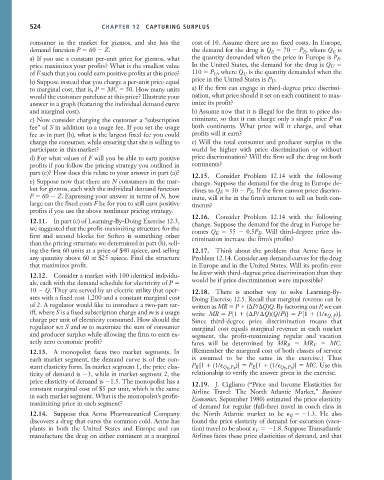Page 550 - Microeconomics, Fourth Edition
P. 550
c12capturingsurplus.qxd 7/22/10 10:41 AM Page 524
524 CHAPTER 12 CAPTURING SURPLUS
consumer in the market for gizmos, and she has the cost of 10. Assume there are no fixed costs. In Europe,
demand function P 60 Z. the demand for the drug is Q E 70 P E , where Q E is
a) If you use a constant per-unit price for gizmos, what the quantity demanded when the price in Europe is P E .
price maximizes your profits? What is the smallest value In the United States, the demand for the drug is Q U
of F such that you could earn positive profits at this price? 110 P U , where Q U is the quantity demanded when the
b) Suppose instead that you charge a per-unit price equal price in the United States is P U .
to marginal cost, that is, P MC 50. How many units a) If the firm can engage in third-degree price discrimi-
would the customer purchase at this price? Illustrate your nation, what price should it set on each continent to max-
answer in a graph (featuring the individual demand curve imize its profit?
and marginal cost). b) Assume now that it is illegal for the firm to price dis-
c) Now consider charging the customer a “subscription criminate, so that it can charge only a single price P on
fee” of S in addition to a usage fee. If you set the usage both continents. What price will it charge, and what
fee as in part (b), what is the largest fixed fee you could profits will it earn?
charge the consumer, while ensuring that she is willing to c) Will the total consumer and producer surplus in the
participate in this market? world be higher with price discrimination or without
d) For what values of F will you be able to earn positive price discrimination? Will the firm sell the drug on both
profits if you follow the pricing strategy you outlined in continents?
part (c)? How does this relate to your answer in part (a)?
12.15. Consider Problem 12.14 with the following
e) Suppose now that there are N consumers in the mar- change. Suppose the demand for the drug in Europe de-
ket for gizmos, each with the individual demand function clines to Q E 30 P E . If the firm cannot price discrim-
P 60 Z. Expressing your answer in terms of N, how inate, will it be in the firm’s interest to sell on both con-
large can the fixed costs F be for you to still earn positive tinents?
profits if you use the above nonlinear pricing strategy.
12.16. Consider Problem 12.14 with the following
12.11. In part (c) of Learning-By-Doing Exercise 12.3, change. Suppose the demand for the drug in Europe be-
we suggested that the profit-maximizing structure for the comes Q E 55 0.5P E . Will third-degree price dis-
first and second blocks for Softco is something other crimination increase the firm’s profits?
than the pricing structure we determined in part (b), sell-
ing the first 60 units at a price of $40 apiece, and selling 12.17. Think about the problem that Acme faces in
any quantity above 60 at $25 apiece. Find the structure Problem 12.14. Consider any demand curves for the drug
that maximizes profit. in Europe and in the United States. Will its profits ever
12.12. Consider a market with 100 identical individu- be lower with third-degree price discrimination than they
als, each with the demand schedule for electricity of P would be if price discrimination were impossible?
10 Q. They are served by an electric utility that oper- 12.18. There is another way to solve Learning-By-
ates with a fixed cost 1,200 and a constant marginal cost Doing Exercise 12.5. Recall that marginal revenue can be
of 2. A regulator would like to introduce a two-part tar- written as MR P ( P/ Q)Q. By factoring out P, we can
iff, where S is a fixed subscription charge and m is a usage write MR P[1 (¢P/¢Q)(Q/P)] P[1 (1/ Q, P )].
charge per unit of electricity consumed. How should the Since third-degree price discrimination means that
regulator set S and m to maximize the sum of consumer marginal cost equals marginal revenue in each market
and producer surplus while allowing the firm to earn ex- segment, the profit-maximizing regular and vacation
actly zero economic profit? fares will be determined by MR R MR V MC.
12.13. A monopolist faces two market segments. In (Remember the marginal cost of both classes of service
each market segment, the demand curve is of the con- is assumed to be the same in the exercise.) Thus
stant elasticity form. In market segment 1, the price elas- P R [1 (1/ Q R ,P R )] P E [1 (1/ Q E ,P E )] MC. Use this
ticity of demand is 3, while in market segment 2, the relationship to verify the answer given in the exercise.
price elasticity of demand is 1.5. The monopolist has a 12.19. J. Cigliano (“Price and Income Elasticities for
constant marginal cost of $5 per unit, which is the same Airline Travel: The North Atlantic Market,” Business
in each market segment. What is the monopolist’s profit- Economics, September 1980) estimated the price elasticity
maximizing price in each segment?
of demand for regular (full-fare) travel in coach class in
12.14. Suppose that Acme Pharmaceutical Company the North Atlantic market to be B 1.3. He also
discovers a drug that cures the common cold. Acme has found the price elasticity of demand for excursion (vaca-
plants in both the United States and Europe and can tion) travel to be about V 1.8. Suppose Transatlantic
manufacture the drug on either continent at a marginal Airlines faces these price elasticities of demand, and that

